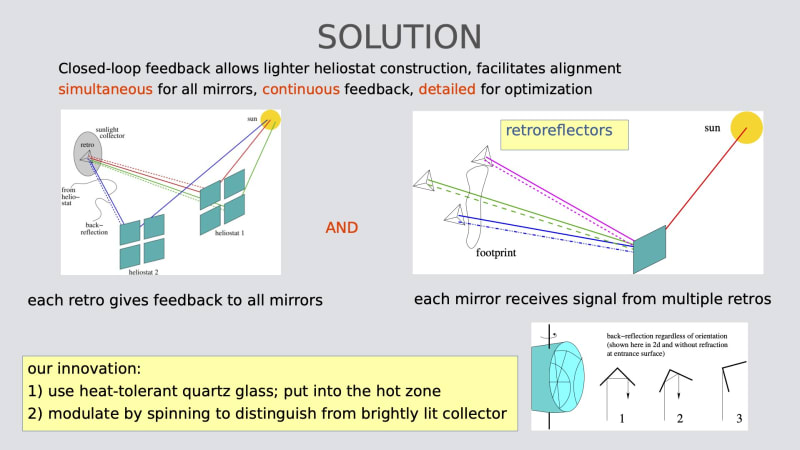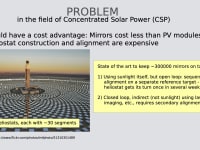Concentrated Solar Power (CSP) uses heliostat mirrors to direct sunlight onto a central collector where heat is converted to electric power. CSP has a significant potential cost advantage over photovoltaics, mirror area being less expensive than photocells.
However, this advantage is offset by the sturdy heliostat construction required for maintaining alignment during daily temperature changes, wind forcing, etc. A long-term goal in CSP is to reduce construction costs to about 50 US-dollars per square meter of mirror area.
Heliostat capital expense could be reduced considerably by light construction relying on closed-loop feedback instead of absolute mechanical stability. There are multiple proposals for such feedback, but none to-date reach all of the following performance goals:
- working simultaneously for all (typically about 10000) heliostats
- being non-disruptive to heliostat operation
- measuring the concentrated sunlight on target, not only deviations
- based on the sunlight itself, i.e., not requiring secondary alignment
- live with feedback delays on the scale of seconds or less to account for wind forces and thermal distortions of optical paths
The present invention will do all that; it is based on the use of multiple corner-cube retro-reflectors (retros) positioned in front of the sunlight collector. These return multiple samples of the sunlight reflected by each heliostat to assess the footprint of light on the collector. Due to the nature of retro-reflectors, each segment mirror of each heliostat receives samples of only its 'own' light.
In order to distinguish the samples taken by multiple retros from each other, and to even see the retro-reflected light on the background of the brightly lit collector, the reflectivity of each retro is modulated at a unique frequency.
A major challenge is the need for the retros to withstand the intense heat near the collector. The present invention does so by making the retros, including their mounts, out of pure quartz glass, which can safely operate at temperatures up to about 1150 deg. C and can withstand severe temperature shocks. The glass only minimally absorbs the incident sunlight. It is heated mainly by infrared radiation from the collector, which may be at up to about 1500C but subtends only a limited solid angle, as seen from the retro.
Modulation of the reflectivity is achieved by spinning each retro about an axis perpendicular to its optical axis, the shaft being a quartz-glass tube. As long as light from a heliostat hits the entrance face of a retro, it will be exactly back-reflected regardless of the detailed orientation; when the retro is facing away from a heliostat, there is no reflection. Thus, on-off reflectivity modulation is achieved.
Value proposition: Keeping all heliostats under closed-loop control with seconds-scale reaction times allows a much lighter construction, thus cutting cost. It also allows tighter concentration of sunlight to
reach temperatures of 1500C suitable for direct hydrogen generation in addition to electric power. Furthermore, the irradiation-power density on the collector may be controlled in detail for maximum efficiency.
Patent pending; a concept demonstrator is currently being tested.
Like this entry?
-
About the Entrant
- Name:Bernhard Adams
- Type of entry:teamTeam members:
- Software used for this entry:python, C++, freecad, diptrace
- Patent status:pending





